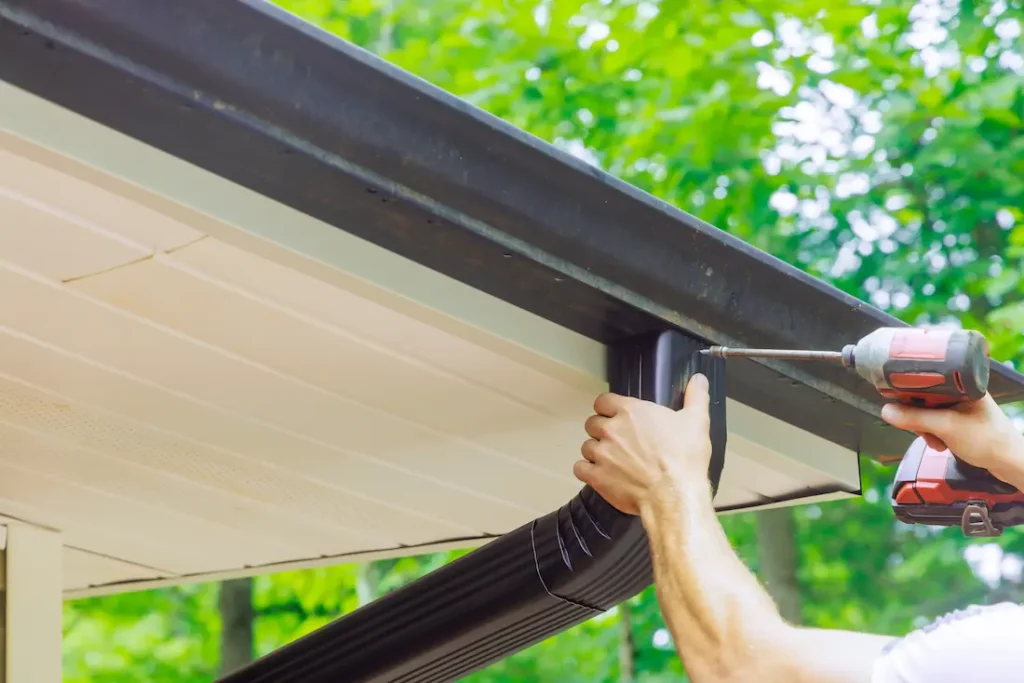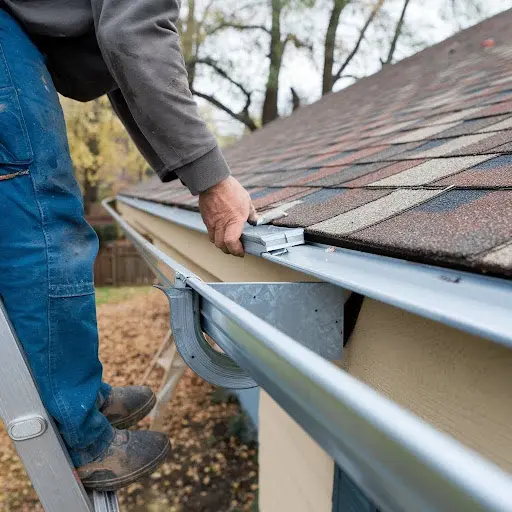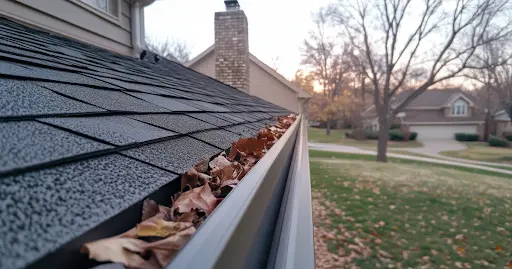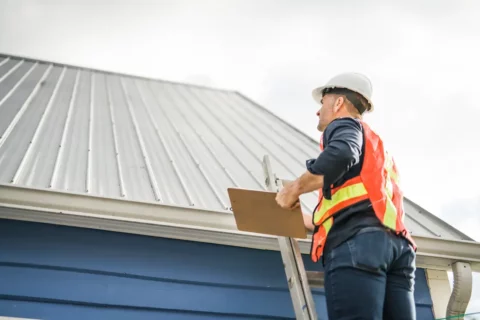
Why Proper Gutter Installation Is Critical to Roof Longevity
When we think about protecting a building’s roof, we often imagine strong shingles, robust underlayment, and top‑notch workmanship. However, one critical component is frequently overlooked, such as the gutter system. For homeowners and business owners in Denver, proper gutter installation is not just a “nice to have”; it’s a key element in ensuring that the roof delivers the decades of service it should.
At 303 Roofer, we handle both residential and commercial roofing installations and repairs for Denver and the surrounding region. In this article, we’ll explain the link between gutters and roof longevity, what proper installation entails, how Denver’s unique climate affects your roof and gutters, and what to look for in a qualified roofing company.
1. How Gutters and Roofs Work Together
Gutters are not just decorative trim. They play a crucial role in redirecting water away from vulnerable parts of your structure, including roof edges, fascia boards, eaves, and ultimately, the foundation. According to one industry article, “although the gutter system and roof are separate home components, they work together … A drier roof stays better protected, and an efficient and effective gutter system plays a major role in protecting the roof.”
1.1 The Water‑flow Path
Rain or melting snow lands on the roof, flows down the slopes, drips into the gutter channel, and then travels through downspouts, being directed away. If that path is blocked, mis‑installed, or undersized, water can back up, overflow, or soak into areas it shouldn’t.
1.2 What Happens If Gutters Fail
- Water that overshoots the gutter or overflows can erode fascia boards, cause rot in the roof deck, or seep under shingles.
- In colder months, when snow melts and refreezes, a poorly functioning gutter can contribute to ice dams. Water backs up behind the ice and then pushes under the roofing materials.
- Water directed too near the foundation may lead to soil movement, settling, or foundation cracks, which in turn affect the roof structure.
In short, a well‑installed, correctly sized, and maintained gutter system helps preserve the integrity of your roof system and the structure beneath it.
2. Why Proper Installation Matters
It’s not enough just to have gutters. How they’re installed and integrated with the roof matters a lot.
2.1 Sizing, Slope, And Positioning
- Gutters must be sized to handle the volume of water that falls on your roof. Oversized roofs, steep slopes, heavy rainfall, or rapid snow‑melt events demand larger capacity.
- The slope (or pitch) of the gutter must allow water to flow effectively toward the downspouts. If the channel is flat or pitched incorrectly, standing water or back‑up may result.
- Downspouts must discharge water at a safe distance from the building (typically several feet or more) to protect the foundation and maintain the structural integrity.
2.2 Integration With Roofing Details
Installation must consider flashing at the roof‑edge, eaves, fascia boards, and how the gutter connects to the roof structure. Poor integration can lead to leaks or trapped moisture under shingles. Industry commentary notes the gutter system is “behind the roof’s flashing and in front of the fascia to create a continuous surface rather than allowing for small crevices where water can seep in.”
2.3 Material, Durability, And Long‑term Performance
The materials and finish matter. As one source notes: “Most gutters today last between 10 and 30 years … Even during snowy winters, gutters can protect the roof … therefore, gutter maintenance is essential to ensure they function properly.” If the gutters themselves deteriorate prematurely, their failure can accelerate roof problems.
2.4 Maintenance And Inspection Are Built Into The Installation
Proper installation should allow for maintenance access, cleaning, debris removal, and should anticipate environmental loading (e.g., large oak trees dropping leaves, heavy snow/rain loads). One article highlights that clogged or damaged gutters can reduce the roof’s lifespan.
3. Why This Matters in Denver, Colorado
The climate and conditions around Denver present specific challenges and advantages for roof and gutter systems.
3.1 Snow And Ice Melt
Denver gets significant snowfall in winter and spring. Rapid warming or sun exposure can lead to snow‑melt running off roofs in sudden volumes. If the gutters or downspouts cannot handle that, you risk water backing up, seeping into eaves, or contributing to ice dam formation at roof edges.
3.2 Rainfall And Storm Events
Although Denver may not be the wettest region in the U.S., heavy rain events, especially spring thunderstorms, can dump large volumes of water over a short period. Properly sized and installed gutters ensure that water is directed safely away from the roof and foundation.
3.3 UV Exposure And Temperature Swings
High altitude and strong sunlight mean building materials face more intense UV radiation and temperature variations, causing repeated expansion/contraction cycles. These can stress gutter bracket attachments or flashing details over time; good installation practices help ensure durability.
3.4 Trees/Debris Considerations
Many Denver neighborhoods are tree‑lined with mature deciduous trees. Leaves, pine needles, seed pods, and other debris can clog gutters if guards or maintenance are lacking. One source notes that “clogged gutters can ruin your gutter system and roof” in a four‑season climate.
Given all of these factors, a roofing company serving Denver must understand local conditions, and at 303 Roofer, we do. We install gutters and roof systems with attention to local climate, snow‑load paths, drainage away from foundations, and maintenance accessibility.
4. The Real Roof Longevity Benefits
Let’s tie it all together: how proper gutter installation helps your roof last longer, and what that really means for homeowners and commercial property owners.
4.1 Less Moisture Infiltration, Less Rot
When gutters function correctly, they prevent standing water or overflow from saturating fascia boards, roof deck edges, or underlayment. Reduced moisture ingress means the roof’s structural components stay healthier longer.
4.2 Fewer Ice Dam Problems
By efficiently channeling water away and allowing meltwater to escape, proper gutters help mitigate ice dam formation and the damage those dams can cause under shingles or at eaves.
4.3 Reduced Edge Damage And Flashing Wear
Water flowing cleanly off the roof and into gutters means less risk of flashing joints being overwhelmed or undermined, thereby protecting edge conditions and extending the life of the flashing.
4.4 Foundation And Entire Structure Protection
By directing water away from the building, gutters reduce soil erosion or foundation moisture intrusion, both of which can cause structural shifts that indirectly affect roof framing or attachments over time.
4.5 Maintenance‑friendly System
A well‑installed gutter that’s accessible, cleanable, and integrated means owners can maintain it rather than waiting for failure. And as one company pointed out: “Regular maintenance of gutters is part of extending your roof’s lifespan.”

5. What to Look For: Gutter Installation Checklist
If you’re hiring a roofing or gutter installation company (or evaluating existing gutters), here are key things to watch for.
- Correct sizing for your roof area ensures that the gutter profile and downspouts match the volume of water expected to be discharged.
- Properly sloped gutters, directed toward downspouts, ensure water drains without pooling.
- Secure attachment gutters should be firmly fixed to the fascia or roof structure; there should be no sagging, pulling, or loose brackets.
- Good flashing integration; roof edge flashing should direct water into the gutter channel, not over or behind it.
- Downspouts should be directed away from the foundation, ideally at least 4–6 feet, to prevent water from accumulating near the base of the soil, where it can cause erosion or seepage.
- Debris‑defense design: Consider gutter guards or mesh if you have many trees. This protects the gutter and roof from clog buildup.
- Inspection of materials ensures gutters can withstand your climate, including the type, thickness, and finish, given Denver’s sun, snow, and temperature swings; durability matters.
- Access for maintenance, clean gutters at least twice a year (spring & fall), and inspect after significant storms. As recommended: “Ideally you should clean your gutters at least twice a year… if your home is surrounded by trees, more frequent cleaning may be needed.”
6. Why Choose 303 Roofer for Your Roofing + Gutter Needs
At 303 Roofer, we understand that a roof is not isolated from the rest of the building envelope; it works in concert with gutters, flashing, fascia, insulation, and ventilation. Here’s what makes us a strong choice in the Denver market:
Local Expertise
We serve residential and commercial clients in the Denver area, so we are familiar with the local climate, snow loads, storm patterns, and relevant code/permit requirements.
Integrated Services
Since we handle both roofing installation and repair, as well as gutter and edge systems, you receive a coordinated solution rather than a piecemeal fix.
Quality Materials
We specify appropriate gutter materials, robust brackets, proper flashing, and downspouts that are designed to withstand Denver’s conditions.
Preventive Approach
We don’t just install and leave; we guide you on maintenance schedules, inspect after storms, and ensure your gutter-roof system is functioning correctly.
Long‑term Value Focus
Our goal is to help your roof last as long as possible. Proper gutter installation is a significant piece of that puzzle.
7. Common Mistakes and How to Avoid Them
Recognizing typical pitfalls can help you avoid costly roof and gutter problems later.
Mistake 1: Undersized Gutters Or Too Few Downspouts
When a system can’t handle the water volume, overflow happens. Ensure the design aligns with the roof and local conditions.
Mistake 2: Gutters Installed Too Far Below The Roof Edge Or With Improper Flashing
If water isn’t guided into the gutter channel cleanly, it may drip behind, into soffits or walls, causing hidden damage.
Mistake 3: Poor Slope Or Sagging Sections
If the water pools instead of flowing, it can corrode materials, add weight, cause sagging, or overflow in storms.
Mistake 4: Ignoring Tree Debris And Maintenance
Leaves, pine needles, and seed pods accumulate. Without cleaning or guards, they clog gutters and reduce drainage performance. One article states that clogged gutters “can ruin your gutter system and roof” in a climate with four seasons.
Mistake 5: Letting Water Discharge Too Close To The Foundation
Even with perfectly installed gutters, if downspouts discharge water next to the foundation, you risk soil erosion or moisture problems that can compromise the overall structural integrity.
8. Maintenance Tips to Maximize Lifespan
Installing correctly is step one, maintenance is step two. Here are practical tips for homeowners and commercial building owners in Denver:
- Clean gutters twice a year (spring and fall) as a minimum; more often if you have trees nearby.
- Inspect after major storms for loose brackets, sagging, overflow evidence, or damage.
- Trim back tree branches that overhang the roof to reduce debris load.
- Verify that downspouts are discharging at least 4‑6 feet from the foundation or into proper drainage systems.
- Check for paint peeling or rot on fascia boards; these can signal gutter overflow or water intrusion.
- For commercial properties, ensure that regular inspections and cleaning are part of your maintenance budget. One piece notes for commercial roofs: “Routine cleaning … extends the roofing system’s longevity.”

Protect Your Roof and Gutter System Today
Proper gutter installation is not a luxury; it’s a necessary investment if you want your roof to reach its full potential. For Denver roofers and building owners, neglecting the gutter system is risking structural damage, shortened roof service life, and unexpected repair costs.
At 303 Roofer, we’re ready to partner with you. Whether you’re planning a new roof installation, gutter retrofit, or simply need a full‑system inspection, we have the local know‑how and the integrated service to keep your roof system and gutters working together. Visit https://303roofer.com or call us today to schedule a consultation and ensure your roof’s longevity is being maximized.
Protect your investment now, don’t wait for the next heavy storm to find out your gutters weren’t ready.



